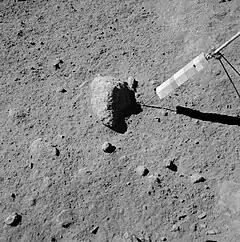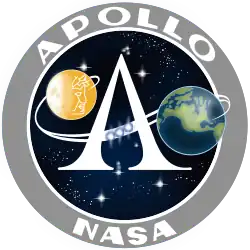Great Scott (lunar sample)
Lunar Sample 15555, better known as "Great Scott", is a lunar sample discovered and collected on the Apollo 15 mission in 1971 in the Hadley-Apennine region of the Moon. The rock is a 9.614 kg (21.20 lb) olivine-normative basalt. It is named after mission commander David Scott, and it is the largest sample returned to Earth from the mission, as well as the most intensively studied.[1] It was collected by Scott on the rim of Hadley Rille, at station 9A.[2]


Great Scott is currently stored at the Lunar Sample Laboratory Facility at the Lyndon B. Johnson Space Center. Pieces of it are on display at the National Museum of Natural History in Washington, DC, the Tellus Science Museum in the state Georgia, the Madrid Deep Space Communications Complex in Spain, the LROC Lunar Exploration Museum at Arizona State University[3] and the Science Museum in London, England.[4]
The term Great Scott was in use as soon as the next mission, Apollo 16, because Charlie Duke used the term just before picking up Big Muley.[5] Big Muley is the largest sample (11.7 kg) returned from the Moon, and Great Scott is the second largest.
Description
Lunar sample 15555 is a coarse-grained, porphyritic rock with rounded olivine phenocrysts (1 mm) and subhedral zoned pyroxene phenocrysts (0.5–2 mm) set in a matrix of poikilitic plagioclase (up to 3 mm).[6][7]
 Great Scott in the Lunar Sample Laboratory Facility. The dark spot surrounded by a light halo in the center of the sample is a Micrometeoroid impact, or "zap pit."
Great Scott in the Lunar Sample Laboratory Facility. The dark spot surrounded by a light halo in the center of the sample is a Micrometeoroid impact, or "zap pit." Cut fragment on display at the National Museum of Natural History
Cut fragment on display at the National Museum of Natural History.jpg.webp) Fragment on display at the Tellus Science Museum, Cartersville, Georgia
Fragment on display at the Tellus Science Museum, Cartersville, Georgia
See also
References
- Apollo 15 Lunar Sample Atlas at L&PI
- Retracing the Steps of Apollo 15: Constellation Region of Interest, LROC
- "Book a Tour | Lunar Reconnaissance Orbiter Camera". lroc.sese.asu.edu. Retrieved 2022-07-29.
- "EXPLORING SPACE – A PIECE OF THE MOON".
- Station 1, Apollo 16 Lunar Surface Journal.
- Sample 15555 summary sheet at L&PI
- Lunar Sample 15555, Lunar Sample Atlas, Lunar and Planetary Institute
